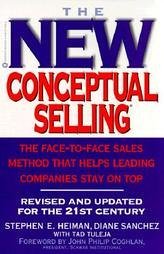
At our office, we decided to read this book as an account team. It was highly recommended by our boss to help better provide better solutions and services to our clients. Essentially, the book helps us listen. Here’s the highlights of how to do joint-venture selling:
– Sales is not a one-sided conversation. It’s a communication together to find the best path. Goal is to become partners in the process
– People buy for their own reasons, not yours.
– Always begins and ends with customer. Goal is to find the reason the customer wants to buy.
– Understand why you’re there. “What do you like about the current project? What don’t you like?”
– Pushy isn’t pushy, if it’s something they need.
– Just because you do more, doesn’t mean you achieve more.
– Phase 1: Get info. Phase 2: Give info/educate. Phase 3: Get commitment. Share commitment with the customer.
– Natural THought. 1. Understand problem (cognitive) 60% > 2. Seek Opportunities (divergent) 30% > 3. Solve. (convergent) 10%
– People love to buy, but they hate being “sold”
– Need to always be in the win-win side of sales. Win for customer. Win for you. IT’s your responsibility to get your customer to win. It’s your responsibility for you to get your company to win.
– At times, you can be in a Win for customer, Lose for you. However, this should lead into a Win/Win.
– Don’t ever oversell on expectations. This is when a customer feels “sold”
– People don’t buy 1″ drill bits, they buy 1″ holes.
– Each sales opportunity is always unique.
– Need to identify the customer gap. Where are they today. Where do they want to go.
– Focus on the concept. And differentiate yourself.
– Be willing to walk when the sale isn’t working.
– Identify the single sales objective and how to move the sales along on each interaction/call.
– There are no problems. Only opportunities
– Be Direct. Be upfront on why we’re meeting.
– Five basic reason why people don’t agree
1. No need to purchase. No fit for service
2. No Money or budget
3. No desire to make changes
4. No urgency. Time is not of the essence
5. No trust. You don’t have credibility.
Credibility is obvious important. This comes with experience, knowledge, presentation of oneself, and associations.
– Different types of questions clients ask. “Why” questions means that the sell isn’t close. “How” questions though mean they’re close to commit.
– Questions build trust, but don’t over-question. Don’t be a know-it-all.
5 types of questions:
1. Confirmation questions > Validate inaccuracies in your knowledge
2. New Information questions > What changed? Reality of current data.
3. Attitude questions > Personal needs/values/attitudes
4. Commitment questions > What action is the customer willing to take.
5. Basic Issue questions > Concerns that could result in loss of sale. (e.g. “WHat if we don’t do this project?”)
– Importance of Golden Silence:
— Golden silence allows for you to think. As well as it will allow for the customer to give additional information.
– What is the value prop for your company in this sale? If choosing between the competitors, what makes you different that the client will choose you.
– How do those features/benefits relate to the customer’s problem.
– Finally, be customer focused, not product focused.
